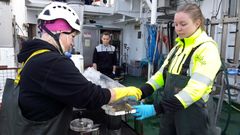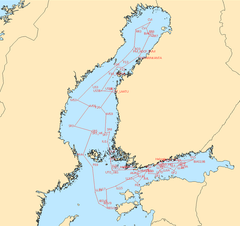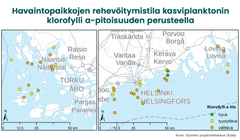Baltic Sea monitoring cruises: Poor oxygen conditions in the northern Baltic Sea and the open Gulf of Finland
The Finnish Environment Institute’s (Syke) marine research vessel Aranda and the coastal monitoring vessel have returned from their late summer monitoring cruises. The oxygen situation in the deep waters of the open Gulf of Finland remains poor, and the seabeds are generally dead at depths over 60 meters. The influx of saline water at the end of last year was not sufficient to improve the oxygen conditions in the deep waters of the main basin. The state of the Bothnian Bay is still better than the southern sea areas. However, its phosphorus content has increased, and the oxygen situation in the deep waters of the Bothnian Sea has deteriorated. The eutrophication of the southern coastal waters is generally at a moderate or poor level.

“The results of the summer monitoring cruises were not surprising, and no major changes in the state of the Baltic Sea were observed. The work to improve the state of the Baltic Sea is long-term and requires continuous monitoring. The results of the work are visible with a delay, and without all the efforts, the state of the sea would certainly be worse,” emphasizes Aranda’s expedition leader, senior researcher Pekka Kotilainen from the Finnish Environment Institute.
The research vessel Aranda’s August cruise focused on the Gulf of Finland, the Archipelago Sea, the Gulf of Bothnia, and the northern parts of the Baltic Proper (Figure 1). At the same time, a coastal monitoring cruise was conducted with the vessel Hessu in the Gulf of Finland and the Archipelago Sea.
In addition to nutrient and oxygen samples, information was collected on algal toxins, changes in benthic fauna and plankton communities, and variables that describe the effects of climate change on the marine environment. Late summer nutrient observations are important for the Baltic Marine Environment Protection Commission’s (HELCOM) assessment of the eutrophication situation.
Observations from the Gulf of Finland: Poor oxygen conditions in deep waters
The oxygen situation in the deep waters of the open Gulf of Finland remains poor (Figure 2). This increases the amount of nutrients that cause eutrophication, as phosphorus reserves in the bottom sediments are released, increasing the amount of phosphate phosphorus in the bottom waters.
Based on observations in June, benthic fauna appeared only in a small part of the open sea observation stations. At depths over 60 meters, the seabeds were generally dead, especially in the western and central Gulf of Finland. The seabed is considered dead when oxygen is depleted, and oxygen-dependent bottom-dwelling animals and fish have disappeared from the area.
Blue-green algae were present throughout the Gulf of Finland, although no actual algal blooms were observed in the open sea during the August cruise. Moon jellyfish, which have been abundant along the Finnish coasts this year, were observed especially in the western Gulf of Finland.
Observations from the Northern Baltic Proper: Higher than average hydrogen sulfide levels
The deep water in the main basin was oxygen-free from 80 meters downwards, and the observed hydrogen sulfide levels were higher than the long-term average. This is due to the accelerated decomposition of organic matter. The concentrations of dissolved nutrients in the surface layer were typically low for the time of year.
No signs of the influx of saline water that entered the Baltic Sea in December 2023 were observed in the samples taken during the research cruise.
Observations from the Gulf of Bothnia and the Archipelago Sea: Good oxygen levels in the deep waters of the Bothnian Sea
No significant changes were observed in the oxygen and nutrient situation in the deep waters of the Bothnian Sea. The oxygen levels in the deep waters have decreased during the 2000s but are still at a relatively good level. The phosphorus levels in the Bothnian Sea have increased throughout the 2000s.
The levels of dissolved phosphorus in the Bothnian Bay have also been rising since the 2010s. Blue-green algae were observed in the surface water in some places during the cruise. Blue-green algae are not observed every year in the open sea of the Bothnian Bay.
Due to the decomposition of organic matter, lower oxygen levels and elevated silicate and ammonium nitrogen levels were also observed in the surface layer.
The oxygen situation in the bottom waters of the Archipelago Sea was moderate. The levels of dissolved phosphorus were higher than the long-term averages for the time of year.
Observations from the coastal waters of the Gulf of Finland and the Archipelago Sea: No changes in the eutrophication situation
Observations from central Gulf of Finland and northern Archipelago Sea support the results of the recent report on the state of Finland’s marine environment. The state of the coastal waters in the Archipelago Sea and the Gulf of Finland is moderate or poor (Figure 3). The level of eutrophication has remained the same in most areas and indicators since the 1990s.
In both the Gulf of Finland and the Archipelago Sea, the effects of eutrophication were visible in some places as deteriorated oxygen conditions even in relatively shallow coastal depths. The state of the benthic fauna communities was poor, or they were completely absent in the outer archipelago of the Gulf of Finland, where the influence of the deep water of the main basin of the Baltic Sea is most evident. At observation sites where oxygen was depleted, or its concentration was low, significantly elevated levels of phosphate phosphorus were measured.
Monitoring data is essential for water protection
In the Finnish Environment Institute’s renewed coastal monitoring, which was updated a year ago, the focus is on the cycles of nutrients and carbon in the coastal waters and sediments of the Gulf of Finland and the Archipelago Sea. Monitoring data supports the assessment of the effectiveness of water protection measures implemented in the catchment areas. Additionally, it sheds light on the role of internal processes in the nutrient cycles of the deep waters and coastal depths of the Baltic Sea, as well as the effects of climate change on the carbon cycles in coastal waters.
Keywords
Contacts
Chief scientist on Aranda, Senior Researcher Pekka Kotilainen, tel. 0295 251 317, firstname.lastname@syke.fi
Chief scientist on Aranda, Research Professor Maiju Lehtiniemi, tel. 0295 251 356, firstname.lastname@syke.fi
State of the seabeds and benthic fauna, Special Researcher Henrik Nygård, tel. 0295 251 469, firstname.lastname@syke.fi
Coastal monitoring, Special Researcher Seppo Knuuttila, tel. 0295 251 286, firstname.lastname@syke.fi
Media service at Finnish Environment Institute
Our Media Service provides information on research, helps journalists find experts for interviews and provides photos for media use.
Our Communication experts will answer your inquiries on weekdays from 9 am to 4 pm.
Images






Links
Finnish Environment Institute - We build hope through research.
Finnish Environment Institute
Latokartanonkaari 11
00790 Helsinki
+358 295 251 000
It is time to move beyond solving environmental problems one by one, to systemic sustainability transformations. The Finnish Environment Institute (Syke) contributes to building a sustainable society through research, information and services. The Finnish Environment Institute is a research institute with 700 experts and researchers located in Helsinki, Oulu, Jyväskylä and Joensuu.

Subscribe to releases from Suomen ympäristökeskus
Subscribe to all the latest releases from Suomen ympäristökeskus by registering your e-mail address below. You can unsubscribe at any time.
Latest releases from Suomen ympäristökeskus
Viikkokatsaus 2.–6.6.202528.5.2025 09:55:41 EEST | Tiedote
Hei! Tässä tiedoksesi meillä Suomen ympäristökeskuksessa ensi viikolla ilmestyviä tiedotteita, uutisia, kampanjoita, blogeja ja uutiskirjeitä. Mukana myös tulevia tapahtumia ja webinaareja. Jakelemme viikkokatsauksen torstaisin STT:n kautta. Koosteet löytyvät myös STT-uutishuoneesta, josta voit tilata kaikki Suomen ympäristökeskuksen tiedotteet.
Municipal climate emissions continue to decline briskly due to the clean-up of the energy sector27.5.2025 06:00:00 EEST | Press release
According to the Finnish Environment Institute, municipal greenhouse gas emissions have declined by around 9 per cent last year compared to 2022. The positive development is mainly due to cleaning up the energy sector, i.e., electricity and district heating production.
Kommunernas klimatutsläpp fortsätter att minska kraftigt tack vare att energisektorn har blivit renare27.5.2025 06:00:00 EEST | Pressmeddelande
Enligt Finlands miljöcentral har kommunernas växthusgasutsläpp minskat med cirka 9 procent jämfört med år 2022. Den positiva utvecklingen beror huvudsakligen på att energisektorn, det vill säga el- och fjärrvärmeproduktionen har blivit renare.
Kuntien ilmastopäästöt jatkavat reipasta laskuaan energiasektorin puhdistumisen ansiosta27.5.2025 06:00:00 EEST | Tiedote
Suomen ympäristökeskuksen mukaan kuntien kasvihuonekaasupäästöt ovat laskeneet viime vuonna noin yhdeksän prosenttia vuoteen 2022 verrattuna. Myönteinen kehitys johtuu pääosin energiasektorin eli sähkön- ja kaukolämmöntuotannon puhdistumisesta.
Viikkokatsaus 26.–30.5.202522.5.2025 10:54:08 EEST | Tiedote
Hei! Tässä tiedoksesi meillä Suomen ympäristökeskuksessa ensi viikolla ilmestyviä tiedotteita, uutisia, kampanjoita, blogeja ja uutiskirjeitä. Mukana myös tulevia tapahtumia ja webinaareja. Jakelemme viikkokatsauksen torstaisin STT:n kautta. Koosteet löytyvät myös STT-uutishuoneesta, josta voit tilata kaikki Suomen ympäristökeskuksen tiedotteet.
In our pressroom you can read all our latest releases, find our press contacts, images, documents and other relevant information about us.
Visit our pressroom